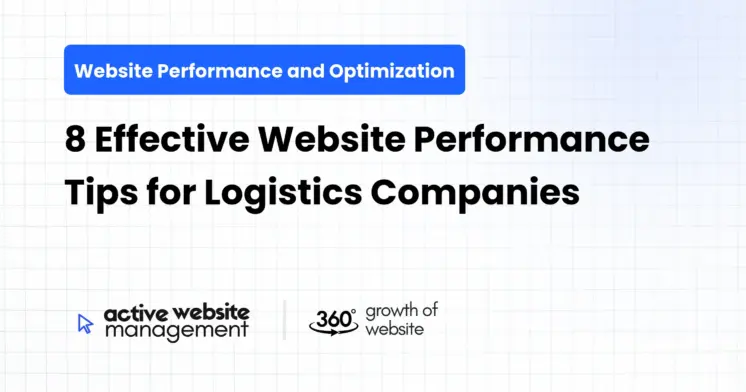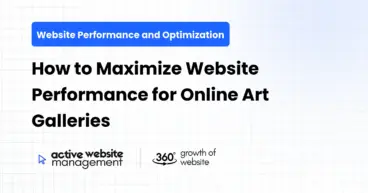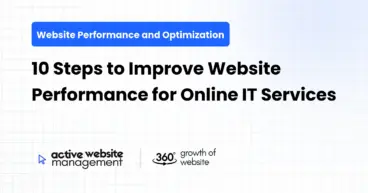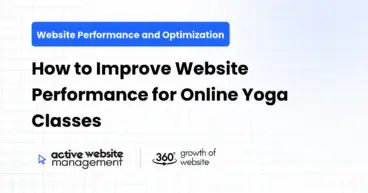February 4, 2025
23 min read
In the fast-paced world of logistics, where milliseconds can mean the difference between securing a lucrative contract and losing out to the competition, your website is your digital storefront. It’s often the first (and sometimes only) impression potential clients have of your business. A slow, clunky, or unreliable website can be disastrous, projecting an image of inefficiency and unreliability – the antithesis of what logistics companies strive for. Think of it: if your website struggles to deliver information quickly, how can you convince a client that you can deliver their goods on time? This article explores eight critical website performance tips designed specifically for logistics companies, empowering you to optimize your online presence and drive business growth.
1. Optimize Images: Deliver Visual Impact Without the Weight
Images are crucial for showcasing your services, fleet, and facilities. They add visual appeal and break up large blocks of text. However, large, unoptimized images are notorious website performance killers. They drastically increase page load times, leading to frustrated visitors and higher bounce rates. This hurts your SEO and directly impacts your bottom line.
What is Image Optimization?
Image optimization is the process of reducing the file size of images without significantly sacrificing visual quality. This ensures your website loads quickly without compromising aesthetics.
Why is Image Optimization Crucial for Logistics Websites?
- Improved User Experience: Faster loading times translate to happier visitors who are more likely to engage with your content and explore your services.
- Enhanced SEO: Search engines like Google prioritize websites with fast loading speeds. Optimized images contribute significantly to improved search engine rankings.
- Reduced Bandwidth Costs: Smaller image files consume less bandwidth, leading to lower hosting costs, especially important for websites with high traffic.
- Better Mobile Performance: Mobile users, who often access websites on slower connections, benefit significantly from optimized images.
How to Optimize Images for Your Logistics Website:
Choose the Right File Format:
- JPEG: Ideal for photographs and images with complex colors. Offers good compression and quality.
- PNG: Best for images with transparency, graphics, and logos. Provides lossless compression, preserving image quality but often resulting in larger file sizes.
- WebP: A modern image format developed by Google, offering superior compression and quality compared to JPEG and PNG. Highly recommended for modern browsers.
Compress Images: Use image compression tools to reduce file size without noticeable quality loss. Several online tools and software options are available, including:
- TinyPNG/TinyJPEG: Excellent for compressing PNG and JPEG images.
- ImageOptim (Mac): A free and powerful image optimization tool.
- Adobe Photoshop: Offers advanced image optimization options.
- ShortPixel (WordPress Plugin): Automatically optimizes images uploaded to your WordPress website.
- Resize Images Appropriately: Avoid using large images and scaling them down in the browser. Resize images to the exact dimensions required for your website layout. Tools like Adobe Photoshop or online image editors can help.
- Use Lazy Loading: Implement lazy loading, which delays the loading of images below the fold (the part of the webpage not visible in the initial viewport) until the user scrolls down. This significantly improves initial page load time.
Add Descriptive Alt Text: Always add descriptive alt text (alternative text) to your images. Alt text serves two crucial purposes:
- Accessibility: It provides context for visually impaired users who rely on screen readers.
- SEO: It helps search engines understand the content of your images and improve your website’s ranking for relevant keywords. For example, instead of “image1.jpg,” use “Logistics Company Warehouse with Forklifts.”
- Use a Content Delivery Network (CDN): A CDN stores copies of your website’s images and other static assets on servers located around the world. When a user visits your website, the CDN serves the content from the server closest to them, resulting in faster loading times, especially for international visitors.
By diligently optimizing your images, you can significantly improve your website’s performance, enhance user experience, and boost your search engine rankings. You’re not just making your website look good; you’re making it perform well.
2. Leverage Browser Caching: Grant Your Visitors the Gift of Speed
Imagine walking into a store you’ve visited before. Wouldn’t it be frustrating if you had to re-introduce yourself and explain your preferences every single time? Browser caching is like that store remembering you. It allows web browsers to store static assets (like images, CSS files, and JavaScript files) locally on a user’s device. When the user revisits your website, the browser retrieves these assets from its cache instead of downloading them again from your server. This dramatically reduces page load times, especially for repeat visitors.
Why is Browser Caching Important for Logistics Websites?
- Faster Loading for Returning Visitors: Repeat visitors, such as clients checking shipment status or tracking orders, will experience significantly faster loading times, improving their overall experience and fostering loyalty.
- Reduced Server Load: By serving static assets from the browser cache, your server handles fewer requests, reducing server load and improving website performance for all users.
- Lower Bandwidth Consumption: Caching reduces the amount of data transferred between your server and users’ devices, lowering bandwidth costs.
- Improved Offline Access: In some cases, caching can allow users to access parts of your website even when they are offline.
How to Implement Browser Caching:
Browser caching is typically configured through your web server’s configuration file (e.g., .htaccess for Apache servers or nginx.conf for Nginx servers). You can also use plugins if you are using a Content Management System (CMS) like WordPress.
Using .htaccess (Apache):Add the following code to your .htaccess file:
<IfModule mod_expires.c>
ExpiresActive On
ExpiresByType image/jpeg "access plus 1 year"
ExpiresByType image/png "access plus 1 year"
ExpiresByType image/gif "access plus 1 year"
ExpiresByType image/svg+xml "access plus 1 year"
ExpiresByType text/css "access plus 1 month"
ExpiresByType application/javascript "access plus 1 month"
ExpiresByType application/x-javascript "access plus 1 month"
ExpiresByType text/html "access plus 1 hour"
ExpiresByType application/xhtml+xml "access plus 1 hour"
</IfModule>
This code tells the browser to cache JPEG, PNG, GIF, and SVG images for one year, CSS and JavaScript files for one month, and HTML and XHTML files for one hour. Adjust the expiration times based on how frequently your content changes.
Using Nginx:Add the following code to your nginx.conf file within the http block:
http {
...
location ~* .(jpg|jpeg|png|gif|svg)$ {
expires 365d;
}
location ~* .(css|js)$ {
expires 30d;
}
location ~* .(html|htm)$ {
expires 1h;
}
...
}
Using WordPress Plugins:Many WordPress plugins, such as W3 Total Cache, WP Super Cache, and LiteSpeed Cache, simplify the process of configuring browser caching. These plugins often offer additional optimization features as well.
Important Considerations:
- Cache Busting: When you update your website’s static assets (e.g., CSS or JavaScript files), you need to “bust” the cache to ensure users download the latest versions. This can be done by appending a version number to the file name (e.g.,
style.css?v=1.1). - Testing: After implementing browser caching, thoroughly test your website to ensure that assets are being cached correctly and that updates are being reflected properly.
By leveraging browser caching, you can provide your visitors with a significantly faster and more enjoyable browsing experience, reduce server load, and lower bandwidth costs. It’s a win-win situation for everyone involved.
3. Minify CSS, JavaScript, and HTML: Streamline Your Code for Speed
Think of your website’s code as a finely tuned engine. Just as excess weight and unnecessary parts can slow down a car, bloated and unoptimized code can significantly impact your website’s performance. Minification is the process of removing unnecessary characters (e.g., whitespace, comments, and line breaks) from your CSS, JavaScript, and HTML code without affecting its functionality. This reduces file sizes, leading to faster download times and improved website performance.
Why is Code Minification Important for Logistics Websites?
- Smaller File Sizes: Minification reduces the size of your CSS, JavaScript, and HTML files, resulting in faster download times.
- Improved Page Load Speed: Faster download times translate to quicker page loading, enhancing user experience and improving search engine rankings.
- Reduced Bandwidth Consumption: Smaller file sizes mean less data transferred between your server and users’ devices, lowering bandwidth costs.
- Better Mobile Performance: Mobile users, who often access websites on slower connections, benefit significantly from minified code.
How to Minify CSS, JavaScript, and HTML:
Several online tools and software options are available for minifying code. You can also use plugins if you are using a CMS like WordPress.
Online Minification Tools:
Simply copy and paste your code into the tool, click the “Minify” button, and download the minified version.
Build Tools (for Developers):Developers often use build tools like Webpack, Parcel, or Gulp to automate the minification process as part of their development workflow. These tools can also perform other optimization tasks, such as concatenation and uglification.
WordPress Plugins:Many WordPress plugins, such as Autoptimize, WP Rocket, and Hummingbird, offer code minification features. These plugins can automatically minify your CSS, JavaScript, and HTML code.
Concatenation: Combining Files for Efficiency
In addition to minification, consider concatenating your CSS and JavaScript files. Concatenation is the process of combining multiple files into a single file. This reduces the number of HTTP requests required to load your website, further improving page load speed.
- Why is Concatenation Important? Each HTTP request adds overhead to the loading process. By reducing the number of requests, you can significantly improve performance.
- How to Concatenate: Build tools like Webpack, Parcel, and Gulp can automate the concatenation process. WordPress plugins like Autoptimize also offer concatenation features.
Best Practices for Code Minification:
- Backup Your Code: Before minifying your code, always create a backup to ensure you can revert to the original version if something goes wrong.
- Test Thoroughly: After minifying your code, thoroughly test your website to ensure that everything is working as expected.
- Automate the Process: Use build tools or plugins to automate the minification process as part of your development workflow. This will save you time and effort and ensure that your code is always optimized.
By minifying and concatenating your code, you can significantly improve your website’s performance, enhance user experience, and reduce bandwidth costs. It’s a simple yet effective way to optimize your website for speed.
Don’t Just Maintain Your Website—
Grow It using Active Website Management! Don't Wait for Growth—Accelerate It with Active Website Management
4. Optimize Your Database: Keep Your Digital Engine Running Smoothly
Your website’s database is the central repository for all your content, settings, and user data. Over time, databases can become bloated and inefficient, leading to slow query times and sluggish website performance. Optimizing your database is like giving your website a tune-up – it keeps everything running smoothly and efficiently.
Why is Database Optimization Important for Logistics Websites?
- Faster Query Times: Optimized databases execute queries faster, resulting in quicker page load times and a more responsive website.
- Reduced Server Load: Efficient database queries reduce the load on your server, improving overall website performance and stability.
- Improved Scalability: An optimized database can handle more traffic and data without performance degradation, allowing your website to scale as your business grows.
- Enhanced Security: Database optimization can help identify and address potential security vulnerabilities.
How to Optimize Your Database:
The specific steps for optimizing your database will depend on the database management system (DBMS) you are using (e.g., MySQL, PostgreSQL, Microsoft SQL Server). However, here are some general tips:
Tools for Database Optimization:
- phpMyAdmin: A popular web-based database management tool for MySQL.
- MySQL Workbench: A graphical database design tool for MySQL.
- WordPress Plugins: Many WordPress plugins, such as WP-Optimize and Advanced Database Cleaner, simplify the process of optimizing your database.
Important Considerations:
- Backup Your Database: Before making any changes to your database, always create a backup to ensure you can restore it if something goes wrong.
- Consult with a Database Administrator: If you are not comfortable optimizing your database yourself, consult with a database administrator.
By optimizing your database, you can significantly improve your website’s performance, enhance user experience, and improve scalability. It’s an essential task for any website owner who wants to ensure their website is running at its best.
Your website’s hosting provider is the foundation upon which your entire online presence is built. A reliable hosting provider ensures that your website is always available, loads quickly, and can handle traffic spikes without performance degradation. Choosing the wrong hosting provider can lead to slow loading times, frequent downtime, and a poor user experience.
Why is Choosing the Right Hosting Provider Important for Logistics Websites?
- Uptime: A reliable hosting provider guarantees a high uptime, ensuring that your website is always available to potential clients and partners. Downtime can lead to lost business opportunities and damage your reputation.
- Speed: A good hosting provider provides fast server response times, contributing to faster page load speeds.
- Scalability: As your business grows, your website will need to handle more traffic and data. A scalable hosting provider can accommodate your growing needs without performance degradation.
- Security: A reputable hosting provider implements robust security measures to protect your website from cyber threats.
- Support: A responsive and knowledgeable support team can help you resolve any issues quickly and efficiently.
Types of Hosting:
- Shared Hosting: Shared hosting is the most affordable option, but it also offers the least amount of resources and control. Your website shares server resources with other websites, which can lead to performance issues during peak traffic times.
- Virtual Private Server (VPS) Hosting: VPS hosting provides more resources and control than shared hosting. Your website is hosted on a virtual server that is isolated from other websites.
- Dedicated Server Hosting: Dedicated server hosting provides the most resources and control. Your website is hosted on a dedicated server that is not shared with any other websites.
- Cloud Hosting: Cloud hosting offers scalability and flexibility. Your website is hosted on a network of virtual servers, allowing you to easily scale resources as needed.
- Managed WordPress Hosting: A hosting environment specifically optimized for WordPress websites, including automated updates, backups, and security features.
Factors to Consider When Choosing a Hosting Provider:
- Uptime Guarantee: Look for a hosting provider with a high uptime guarantee (e.g., 99.9% or higher).
- Server Response Time: Choose a hosting provider with fast server response times.
- Scalability: Ensure that the hosting provider can accommodate your growing needs.
- Security Features: Look for a hosting provider with robust security features, such as firewalls, malware scanning, and intrusion detection systems.
- Support: Choose a hosting provider with a responsive and knowledgeable support team.
- Location of Servers: Choose a hosting provider with servers located in the geographic regions where your target audience is located.
- Price: Compare the prices of different hosting providers, but don’t sacrifice quality for cost.
Specific Considerations for Logistics Companies:
- Integration with Logistics Software: Ensure that your hosting provider supports the integration of your website with any logistics software you use.
- Global Reach: If you have a global clientele, choose a hosting provider with servers located around the world or a Content Delivery Network (CDN).
- High Availability: Logistics operations often require 24/7 availability. Choose a hosting provider that guarantees high availability.
By choosing a reliable hosting provider, you can ensure that your website is always available, loads quickly, and can handle traffic spikes without performance degradation. It’s a crucial investment in your online presence.
6. Use a Content Delivery Network (CDN): Deliver Content Globally with Speed
Imagine having multiple copies of your website strategically located around the world. That’s essentially what a Content Delivery Network (CDN) does. A CDN is a network of servers located in various geographic locations. It stores cached copies of your website’s static assets (e.g., images, CSS files, JavaScript files) and delivers them to users from the server closest to them. This significantly reduces latency and improves website loading times, especially for users who are geographically distant from your origin server.
Why is Using a CDN Important for Logistics Websites?
- Faster Loading Times for Global Users: Logistics companies often have clients and partners located around the world. A CDN ensures that your website loads quickly for all users, regardless of their location.
- Reduced Latency: Latency is the delay between a user’s request and the server’s response. A CDN reduces latency by delivering content from a server that is closer to the user.
- Improved User Experience: Faster loading times translate to a better user experience, which can lead to increased engagement and conversions.
- Reduced Server Load: A CDN offloads traffic from your origin server, reducing server load and improving website performance.
- Increased Reliability: A CDN can provide redundancy and fault tolerance, ensuring that your website remains available even if your origin server goes down.
- SEO Benefits: Search engines like Google consider website loading speed as a ranking factor. A CDN can help improve your website’s search engine rankings.
How Does a CDN Work?
- A user requests a webpage from your website.
- The CDN determines the user’s geographic location.
- The CDN delivers the static assets (e.g., images, CSS files, JavaScript files) from the server closest to the user.
- The dynamic content is retrieved from your origin server.
- The webpage is assembled and delivered to the user.
Choosing a CDN Provider:
Several CDN providers are available, each offering different features and pricing plans. Some popular CDN providers include:
- Cloudflare: A popular CDN provider offering a free plan and a variety of paid plans.
- Akamai: A leading CDN provider offering enterprise-grade features.
- Amazon CloudFront: Amazon’s CDN service, integrated with other AWS services.
- Fastly: A CDN provider focusing on performance and security.
- Google Cloud CDN: Google’s CDN service, integrated with other Google Cloud Platform services.
Factors to Consider When Choosing a CDN Provider:
- Global Coverage: Choose a CDN provider with servers located in the geographic regions where your target audience is located.
- Performance: Evaluate the CDN provider’s performance based on metrics such as latency and throughput.
- Security: Look for a CDN provider with robust security features, such as DDoS protection and web application firewall (WAF).
- Pricing: Compare the prices of different CDN providers.
- Ease of Use: Choose a CDN provider that is easy to set up and manage.
- Support: Choose a CDN provider with a responsive and knowledgeable support team.
Implementing a CDN:
The process of implementing a CDN typically involves the following steps:
- Sign up for an account with a CDN provider.
- Configure your website to use the CDN. This usually involves changing your DNS settings or installing a plugin.
- Test your website to ensure that the CDN is working correctly.
By using a CDN, you can significantly improve your website’s performance, enhance user experience, and increase reliability. It’s a must-have for logistics companies with a global clientele.
7. Optimize for Mobile: Embrace the Mobile-First World
In today’s mobile-first world, a significant portion of your website traffic likely comes from mobile devices. Optimizing your website for mobile is no longer optional – it’s essential for providing a positive user experience, improving search engine rankings, and driving business growth. A website that is not optimized for mobile devices can be difficult to navigate, slow to load, and frustrating to use, leading to high bounce rates and lost business opportunities.
Why is Mobile Optimization Important for Logistics Websites?
- Increased Mobile Traffic: More and more people are using mobile devices to access the internet. Optimizing your website for mobile ensures that you can reach a wider audience.
- Improved User Experience: A mobile-optimized website provides a better user experience for mobile users, making it easier for them to find the information they need.
- Enhanced SEO: Google prioritizes mobile-friendly websites in its search engine rankings. Mobile optimization can help improve your website’s search engine visibility.
- Increased Conversions: A mobile-optimized website can lead to increased conversions, as mobile users are more likely to complete a purchase or contact you if they have a positive experience.
- Competitive Advantage: In the competitive logistics industry, a mobile-optimized website can give you a significant advantage over your competitors.
How to Optimize Your Website for Mobile:
- Use a Responsive Design: Responsive design is a web design approach that allows your website to adapt to different screen sizes and resolutions. This ensures that your website looks and functions well on all devices, from smartphones to tablets to desktop computers.
- Optimize Images for Mobile: Optimize your images for mobile devices by reducing their file sizes and using appropriate image formats.
- Use a Mobile-Friendly Theme: If you are using a CMS like WordPress, choose a mobile-friendly theme that is designed to work well on mobile devices.
- Simplify Navigation: Simplify your website’s navigation to make it easy for mobile users to find the information they need. Use clear and concise labels and avoid using too many menu items.
- Use Mobile-Friendly Forms: Ensure that your website’s forms are easy to fill out on mobile devices. Use large input fields and avoid requiring users to enter too much information.
- Enable Mobile Caching: Enable mobile caching to improve website loading times on mobile devices.
- Test Your Website on Mobile Devices: Regularly test your website on different mobile devices and browsers to ensure that it is working correctly.
Tools for Mobile Optimization:
- Google Mobile-Friendly Test: A free tool that allows you to test whether your website is mobile-friendly.
- Google PageSpeed Insights: A free tool that provides recommendations for improving your website’s performance on both desktop and mobile devices.
- Browser Developer Tools: Most modern web browsers include developer tools that allow you to simulate mobile devices and test your website’s responsiveness.
Specific Considerations for Logistics Companies:
- Mobile Tracking: Ensure your shipment tracking functionality is easily accessible and functions correctly on mobile devices.
- Mobile Contact Options: Prominently display phone numbers and email addresses for easy mobile contact.
- Mobile-Friendly Quote Requests: Simplify the quote request process for mobile users.
By optimizing your website for mobile, you can provide a better user experience for mobile users, improve search engine rankings, and drive business growth. It’s a crucial step for success in today’s mobile-first world.
8. Active Website Management: Continuous Improvement for Long-Term Success
Website performance optimization isn’t a one-time task; it’s an ongoing process that requires active website management. The web is constantly evolving, with new technologies, algorithms, and user expectations emerging all the time. To maintain optimal website performance and stay ahead of the competition, you need to continuously monitor your website, identify areas for improvement, and implement changes accordingly.
Why is Active Website Management Important for Logistics Websites?
- Maintain Optimal Performance: Active website management ensures that your website continues to perform at its best over time.
- Adapt to Changing Technologies: The web is constantly evolving. Active website management allows you to adapt to new technologies and ensure that your website remains compatible with the latest browsers and devices.
- Improve User Experience: By continuously monitoring your website and gathering user feedback, you can identify areas for improvement and enhance the user experience.
- Enhance SEO: Search engines like Google are constantly updating their algorithms. Active website management helps you stay up-to-date with the latest SEO best practices and improve your website’s search engine rankings.
- Stay Ahead of the Competition: In the competitive logistics industry, active website management can give you a significant advantage over your competitors.
Key Activities for Active Website Management:
- Website Performance Monitoring: Regularly monitor your website’s performance using tools like Google Analytics, Google PageSpeed Insights, and GTmetrix. Track key metrics such as page load time, bounce rate, and conversion rate.
- User Feedback Analysis: Gather user feedback through surveys, feedback forms, and social media monitoring. Analyze the feedback to identify areas for improvement.
- Content Updates: Regularly update your website’s content to keep it fresh and relevant. Add new blog posts, case studies, and testimonials to showcase your expertise and attract new visitors.
- Security Updates: Regularly update your website’s software, including your CMS, plugins, and themes, to protect against security vulnerabilities.
- SEO Audits: Conduct regular SEO audits to identify areas for improvement and ensure that your website is optimized for search engines.
- Competitor Analysis: Monitor your competitors’ websites to identify their strengths and weaknesses. Use this information to improve your own website.
- A/B Testing: Conduct A/B tests to compare different versions of your website and identify which ones perform best.
- Regular Backups: Regularly back up your website to protect against data loss.
The Role of Active Website Management:
To streamline these complex processes, consider leveraging a specialist in active website management like Active Website Management .
Benefits of Partnering with Active Website Management:
- Expertise: Gain access to a team of experienced website management professionals.
- Time Savings: Free up your internal resources to focus on core business activities.
- Improved Performance: Improve your website’s performance and user experience.
- Enhanced Security: Protect your website from cyber threats.
- Increased ROI: Maximize the return on your website investment.
By embracing active website management, you can ensure that your website continues to perform at its best, adapt to changing technologies, and deliver a positive user experience. It’s an essential investment for long-term success in the competitive logistics industry.
In conclusion, implementing these eight effective website performance tips will significantly improve your logistics company’s online presence. By optimizing images, leveraging browser caching, minifying code, optimizing your database, choosing a reliable hosting provider, using a CDN, optimizing for mobile, and embracing active website management, you can create a fast, reliable, and engaging website that attracts new clients, strengthens relationships with existing partners, and drives business growth. Remember, your website is your digital storefront, and its performance directly impacts your bottom line. Invest in its optimization and reap the rewards.







